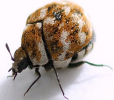
Problems with Carpet Beetles,are controllable under professional care. Our treatment goal is to stop a problem at its source so it doesn’t keep coming back. Using state-of-the art equipment and methods, our licensed exterminators will inspect your home’s environment and construction to identify the problem and determine the best course of action. Contact us today!
Carpet beetles typically invade warehouses, homes, museums, and other locations where they have access to fabrics, carpets, furs, stored foods, and even preserved museum specimens. Damage is caused by the larval stage of these beetles and they are most likely to feed in dark locations on animal products. Typically that will include wool, leather, silk, fur, hair, pet hair, and feathers.
Sometimes they feed on stored agricultural products such as certain spices and grains. They don’t intentionally feed on synthetic fibers, but they have been known to feed on blends of wool and synthetics.
Without professional help, it may be difficult to tell the difference between damage from a moth and carpet beetle, but generally the beetles are more likely to damage a large area on one portion of a garment or carpet while moth damage more often appears as scattered holes.
There are 3 common species of Carpet Beetles and they include:
All three carpet beetle species have similar life cycles with similar variations due to food sources and environmental temperatures. These insects may be brought into the home at any stage of development (egg, larvae, pupae, or adult) and migrate or collect in and around baseboards, air ducts, furniture stuffing, and even in the lint in corners.
The adult beetle will lay eggs on a food source, and they hatch in about 2 weeks. The larvae prefer dark, secluded places, yet they are easy to spot because the larvae shed skins and leave fecal pellets, the size of grains of salt.
The adult beetles adults but seek out pollen and nectar. They are attracted to sunlight and are commonly found feeding on the flowers
The varied carpet beetle (shown above)
The adult is about between 1/16th and 1/8th inch long and black with patterns of white, brown, and dark yellow scales on its wing covers. Older adults lose the scales that form this pattern and so, these beetles will appear solid brown or even black. In outdoor environments, female beetles will search out spider webs or nests of bees, wasps, and birds in which to lay their eggs. These nests contain dead insects, beeswax, pollen, feathers, or other debris that can serve as larval food.
Typically the female will lay 40 eggs, the larvae will go through 8 stages in about 8 to 12 months, and the adults live 2 to 6 weeks.Indoors the beetles behave differently and will seek out wool carpets and rugs, woolen goods, and other dried animal or plant products.
Mature larvae are about the same length as adults and are covered with dense tufts of hair They have alternating light and dark brown transverse stripes and are distinguishable from other carpet beetle larvae because they are broader in the rear and narrower in front. Adults usually appear in spring or early summer; indoors, they are often seen near windows.
Furniture Carpet Beetles
These beetles are slightly larger and rounder than the varied carpet beetle adult. Their coloration can vary, but they generally have white and dark yellow to orange scales, which creates a mottled appearance. Older adults can also appear black because they will have lost these colorful scales

These beetles range from 1/8 to 3/16 inch in length and they are shiny black and dark brown. Full-sized larvae may be as long as 5/16 inch. They range in color from light brown to almost black. Larvae are shiny, smooth, hard, and are covered with short, stiff hairs. Their body tapers toward the rear and ends in a tuft of long hairs.
Successful carpet beetle control depends on integrating the use of sanitation and exclusion, and, where necessary, insecticides. Carpet beetles can be difficult indoor pests to control because they have the ability to find food in obscure places and to disperse widely throughout a building.
An important first step is to eliminate accumulations of lint, hair, dead insects, and other debris that serve as food for carpet beetles. Throw out badly infested items. Remove bird, rodent, bee and wasp nests, and old spider webs, which may harbor infestations. Examine cut flowers for adult beetles. Clean out closets, thoroughly clean carpets, drapes, and upholstered furniture.
Regular and thorough cleaning of rugs, draperies, upholstered furniture, closets, and other locations where carpet beetles congregate is an important preventive and control technique. Frequent, thorough vacuuming will also help. Garments and linens should be washed because food and perspiration stains will attract insects. Cleaned items should be sealed in a protective plastic bag or other suitable container to prevent infestation.
Wild game trophies or animal specimens should be regularly cleaned or periodically placed in a freezer for approximately 2 weeks. When beetles or moths get into furniture or mattress stuffing, professional fumigation may be required if the furniture is to be saved. Otherwise, disposal is recommended. For items that can’t be easily cleaned or areas that are not accessible, it is best to consult with a professional exterminator on the use of insecticides. These products can be hazardous when misapplied.